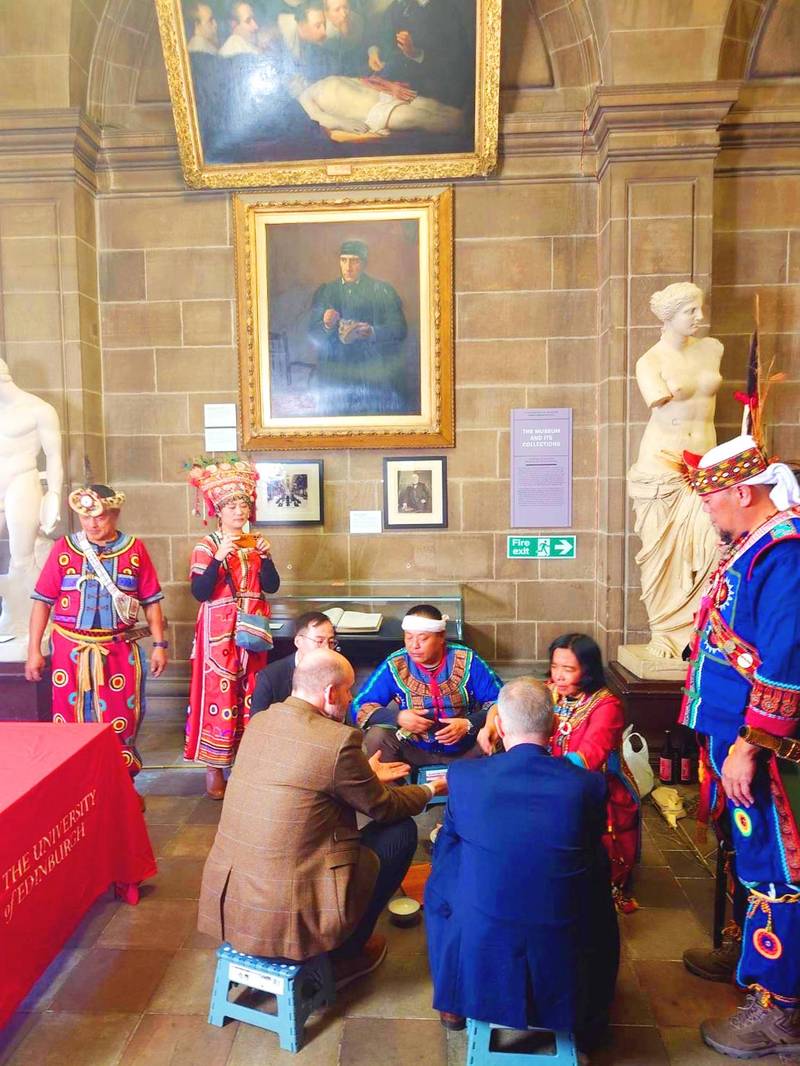《TAIPEI TIMES》 Paiwan skulls find a home in Tainan museum

People attend a ceremony at the University of Edinburgh on Friday last week before the return of four Paiwan warrior skulls to Taiwan. Photo: CNA
/ Staff writer, with CNA
Four tribal warrior skulls on Monday found peace in Tainan’s Museum of Archaeology after being repatriated from the University of Edinburgh.
The skulls, from the indigenous Paiwan people, arrived in Taiwan late on Sunday night and were transported to the museum, which is the Tainan branch of the National Museum of Prehistory, early on Monday.
A ceremony was held later that day to induct the spirits of the four warriors into their new abode. It was attended by Council of Indigenous Peoples Minister Icyang Parod and Museum of Archaeology curator Tien Shih-han (田詩涵).
The Museum of Archaeology would be home to the skulls while they are studied by morphology researchers, Tien said.
The museum would hold discussions with Sinevaudjan, the Paiwan village in Pingtung County’s Mudan Township (牡丹), which is where the skulls originated, to decide what to do with them when the study is completed, she said.
Icyang Parod said that this was the first time Taiwan had asked for the remains of its indigenous people to be repatriated.
The event was also a milestone in modern societies becoming more aware of the rights of indigenous people, he said, adding that the process took more than three years of negotiations between Taiwanese and British organizations, including the university, where the skulls had been since 1907.
The university holds one of the largest and most historically significant collections of ancestral remains, notably skulls.
Tom Gillingwater, the University of Edinburgh’s chair of anatomy, said in an interview on Friday last week that the university had worked closely with Taipei’s representative office in Edinburgh to ensure the skulls were repatriated.
During the process, it worked to understand on what basis Taiwan was making the request and who the rightful owners of the skulls were, Gillingwater said.
“We need to ensure that we are returning the remains to the right people. And so, we had to undertake some research ourselves, essentially due diligence, to make sure that the skulls we are returning are what we think they are,” he said.
“The request [of Taiwan] came from the minister for indigenous peoples in Taiwan. So, we were absolutely satisfied that they were the correct people to be returning the skulls to,” he added.
The university formalized a repatriation policy into its constitution more than 30 years ago to encourage members of the university to work with communities around the world to repatriate human remains whenever requested, Gillingwater said.
In 2019, “we returned skulls from Vedda individuals back to the tribal chief from Sri Lanka,” he said. “Before that, we had a history of returning remains to areas where indigenous people lived in Australia and New Zealand.”
The anatomy expert spoke with reporters after he was invited to participate in ceremonial rituals to welcome the skulls back to Taiwan, initiated by a Paiwan delegation at the university.
As well as Gillingwater, British representatives at the ceremony included University of Edinburgh vice principal Gavin McLachlan, Malcolm MacCallum, curator of the university’s Anatomical Museum, and Edinburgh Lord Provost Robert Aldridge.
Along with Representative to the UK Kelly Hsieh (謝武樵) and the head of the mission’s Edinburgh branch, Chang Chia-change (張嘉政), the delegation also included Mudan Township Mayor Pan Chuang-chih (潘壯志) and Council of Indigenous Peoples Deputy Minister Calivat Gadu.
Calivat Gadu told reporters that eight other skulls remain unaccounted for.
They are probably in Japan, he said.
The representatives and dignitaries gave their full attention to Paiwan shaman Civur Malili who communicated with the spirits of the skulls and Paiwan sun deity Qadaw.
While speaking on behalf of the four fallen warriors, she brought tears and laughter to the audience.
Civur Malili, known in her language as a pulingaw, said that during her communications with the deity and ancestral spirits, the four warriors were initially reserved about returning to Taiwan, because they had died in unnatural circumstances and could therefore bring their descendants bad luck.
The spirits eventually agreed to return home after they were reassured that it would help to pass historic memories to future generations, Civur Malili said.
On Oct. 28, when they embarked on the journey home, “we strongly felt the ancestral spirits really wanted to go home,” she said.
With the help of the Taipei Representative Office in the UK and some improvisation, the pulingaw performed the ritual successfully and received permission from Qadaw and the ancestral spirits to bring the four skulls back to Taiwan.
Toward the end of the ritual, Civur Malili conveyed gratitude to the University of Edinburgh for taking proper care of the skulls, going as far as to welcome MacCallum into the ritual spiritual circle to embrace the curator in a nod to his efforts.
The skulls of the Paiwan warriors were taken by the Japanese during an 1874 punitive expedition known as the Mudan Incident in Shimen (石門) in the Pingtung County township. It was launched in response to the massacre of 54 shipwrecked Ryukyuan sailors by Paiwan warriors three years earlier.
The skulls were thought to have been taken as war trophies by Japanese soldiers and were carried to Japan by an unnamed US Navy officer who had accompanied the Japanese as a military adviser.
Before the skulls reached the University of Edinburgh in 1907, they were in the possession of Stuart Eldrige, a US doctor and skull collector living in Yokohama, Japan, and John Anderson, the first curator of the Indian Museum in Calcutta.
新聞來源:TAIPEI TIMES













